Overview
The article identifies nine essential ecological performance metrics crucial for land acquisition processes. These metrics—carbon emissions, water usage, waste management, and community engagement—are vital for organizations aiming to enhance their sustainability practices. By ensuring compliance with environmental regulations, these metrics contribute to more responsible and effective land procurement strategies. Understanding the complexities of land acquisition, including legal and regulatory challenges, is imperative for organizations. Emphasizing these metrics not only aligns with sustainability goals but also positions organizations to navigate the intricacies of the procurement landscape effectively.
Introduction
In the rapidly evolving landscape of land acquisition, organizations increasingly recognize the critical need to integrate sustainability metrics into their operational frameworks. As demand for energy and infrastructure projects escalates, companies encounter mounting pressures to adopt practices that not only comply with regulatory standards but also enhance their ecological performance. Key metrics—ranging from carbon emissions and water usage to waste management and community engagement—are essential for fostering responsible land acquisition practices.
As industry leaders navigate these complexities, they face legal and regulatory challenges that can hinder progress. Innovative technologies and comprehensive strategies become paramount in ensuring that land services not only support business objectives but also contribute positively to the environment and society at large. The integration of sustainability metrics not only addresses these challenges but also positions organizations as responsible stewards of the land, paving the way for a more sustainable future.
Harbinger Land: Comprehensive Solutions for Land Services in Energy and Infrastructure
Harbinger Land excels in providing comprehensive services specifically designed for energy and infrastructure projects across the United States. Their extensive offerings include:
- Site and right-of-way procurement
- Title research
- GIS mapping
- Data processing
In 2025, the property acquisition sector is facing significant challenges, as developers encounter profit declines due to slow growth and rising expenses. What does this mean for the industry? Despite these hurdles, Harbinger Land distinguishes itself by leveraging cutting-edge technology, including AI-powered title research software, to enhance operational efficiency and client satisfaction.
The company's veteran team is adept at swiftly deploying large teams to meet diverse project demands, ensuring that services are timely and tailored to the unique requirements of clients such as natural gas companies, solar developers, and municipalities. This adaptability is crucial in a landscape where the demand for nonresidential property development is varied, yet essential services like property grading and drainage remain in high demand. As the industry evolves, innovative solutions such as Autodesk Forma are revolutionizing land planning and development. This evolution underscores the necessity of comprehensive land services in navigating the complexities of energy and infrastructure projects.
In summary, as the challenges in property acquisition continue to grow, the expertise and innovative solutions offered by Harbinger Land are indispensable for clients looking to thrive in this dynamic environment.
ESG Criteria: Key Metrics for Evaluating Ecological Performance
ESG criteria represent vital standards that evaluate a company's commitment to sustainable practices. Key indicators include:
- Carbon emissions
- Water consumption
- Waste management
- Community involvement
These criteria enable organizations to gauge their ecological performance metrics and align their operations with sustainability objectives. By integrating ESG criteria into property procurement processes, companies not only enhance their reputation but also ensure compliance with regulatory standards. This strategic approach is essential for navigating the complexities of land acquisition and meeting the growing demand for sustainability.
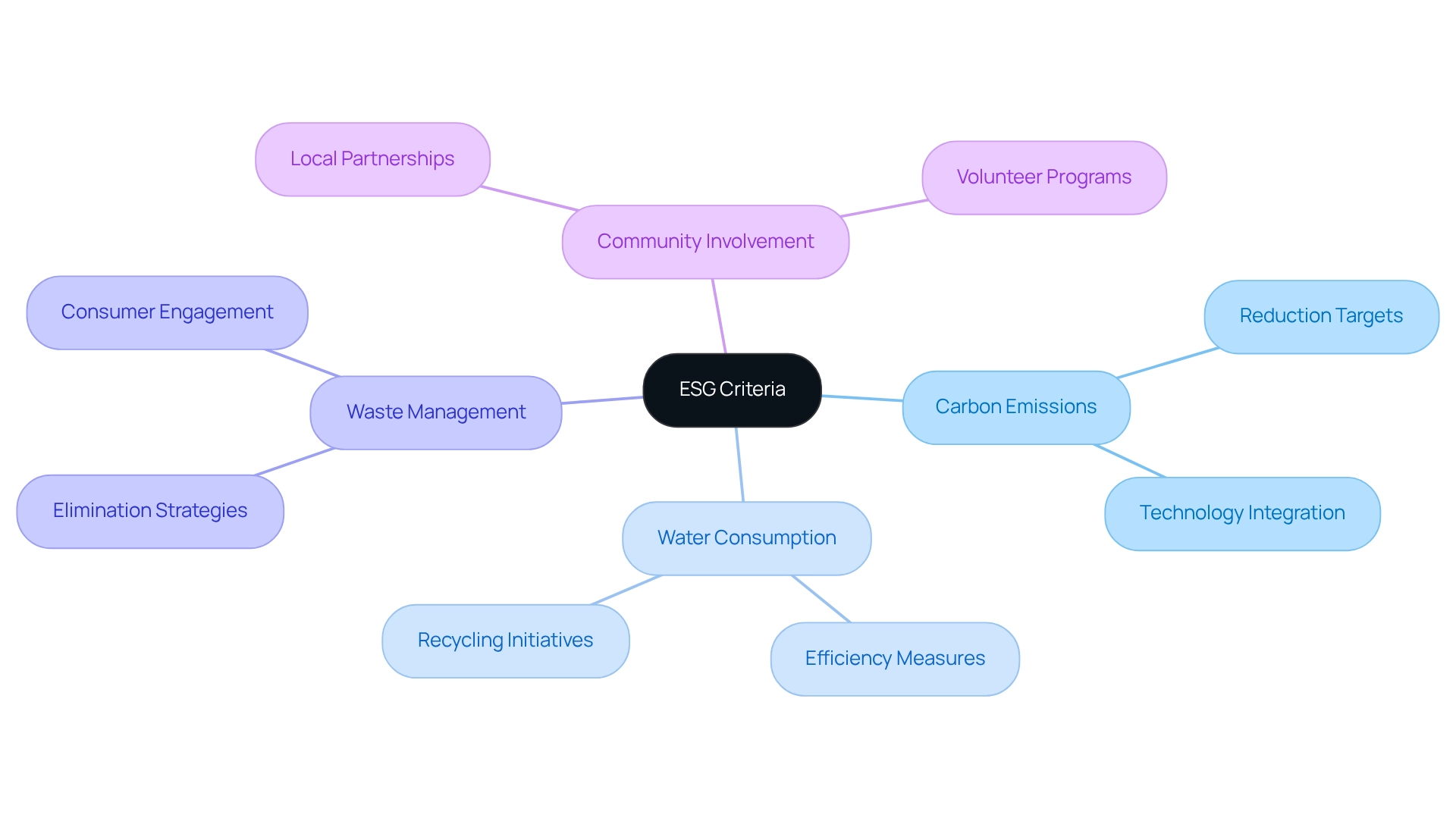
Carbon Emissions: A Critical Metric for Environmental Impact Assessment
Carbon emissions serve as a vital metric for evaluating the environmental impacts of property acquisition projects. Organizations must assess their carbon footprint, encompassing emissions from use changes, transportation, and construction activities. In 2025, the anticipated carbon footprint associated with use changes in the U.S. is projected to be significant, necessitating proactive reduction measures. By implementing effective strategies to curtail carbon emissions, companies can not only comply with environmental regulations but also enhance their sustainability profiles.
The utilization of tools such as carbon calculators and life cycle assessments is crucial for quantifying emissions and identifying reduction opportunities. Expert insights emphasize that a comprehensive approach to managing carbon footprints in service areas can lead to substantial improvements in environmental performance. For instance, successful property acquisition strategies have demonstrated that integrating carbon management practices can significantly lower emissions.
Recent data indicates that carbon emissions from property development projects are under heightened scrutiny, with increasing attention on their impacts during environmental evaluations. The intricacies of managing these emissions are highlighted by case studies, such as the escalation of aviation emissions under the EU ETS, which illustrate the challenges encountered across various sectors. As organizations navigate these complexities, understanding the implications of carbon emissions on property acquisition projects in 2025 will be essential for fostering sustainable development.
Water Usage and Conservation: Essential Metrics for Sustainable Land Management
Effective water usage and conservation measurements are essential for achieving sustainability in land management. Organizations must diligently monitor their water usage and adopt conservation methods to minimize waste. Key metrics, such as water footprint assessments and efficiency ratios, serve as valuable tools for identifying areas of improvement. As we approach 2025, the emphasis on advanced irrigation technologies—such as precision irrigation and moisture sensors—has become increasingly vital. These technologies enable companies to significantly reduce water usage while enhancing their ecological performance metrics by optimizing water application based on real-time data.
The U.S. Geological Survey (USGS) has monitored water usage trends since 1950, revealing that freshwater extractions in 2015 were 9 percent lower than in 2010. This signifies a positive shift towards more sustainable methods. As Molly A. Maupin noted, "This total has varied less than 3 percent since 1985 as withdrawals have stabilized for the two largest uses—thermoelectric power and irrigation." This ongoing analysis informs policymakers and stakeholders about evolving water demand and supply, aiding in future planning efforts.
Furthermore, organizations can benefit from collaboration, as demonstrated by members of The Cool Farm Alliance, who share conservation ideas for a sustainable future. Their joint efforts focus on innovative methods that enhance water conservation, making them a significant asset for property procurement experts. By utilizing national and state reports from the National Agricultural Statistics Service (NASS), which offer insights into water usage trends and conservation indicators, companies can remain informed and make data-driven choices in their resource management strategies.
Expert opinions underscore the significance of water conservation in property procurement, emphasizing that sustainable practices not only safeguard resources but also improve project feasibility. As irrigation technologies advance, their influence on water conservation becomes increasingly important. It is essential for property procurement experts to incorporate these measures into their strategies for sustainable resource management.
Waste Management and Reduction: Metrics for Minimizing Ecological Footprints
Effective waste management and reduction metrics, along with ecological performance metrics, are essential for minimizing the ecological footprint of land acquisition projects. Companies must diligently monitor waste generation, recycling rates, and landfill diversion efforts to assess their environmental impact. Implementing a waste hierarchy that emphasizes reduction, reuse, and recycling can lead to substantial decreases in waste output. Consider the adoption of waste-to-energy (WTE) conversion technologies, which not only mitigates waste but also generates energy, showcasing a sustainable alternative to traditional disposal methods. A recent case study highlights that WTE solutions offer a dual benefit of waste reduction and energy production, positioning them as a key strategy for organizations aiming to enhance sustainability.
In 2025, the construction sector is anticipated to witness higher recycling rates, propelled by innovative methods that align with ecological objectives. Current statistics indicate that states like Michigan and Indiana face significant landfill waste challenges, having the highest landfill waste rates, while Tennessee and Texas demonstrate more effective waste management strategies. By adopting sustainable waste management methods, organizations can greatly improve their ecological performance metrics and support a circular economy, ultimately benefiting both their operations and the communities they serve.
To further improve waste management efforts, companies should consider setting specific recycling targets and regularly reviewing their waste management strategies to ensure continuous improvement. What steps will your organization take to enhance its waste management practices? The time to act is now.
Supply Chain Responsibility: Metrics for Sustainable Land Acquisition Practices
Supply chain accountability measures are crucial for ensuring sustainable property procurement methods. Companies must evaluate their suppliers against environmental and social criteria, including:
- Resource sourcing
- Labor practices
- Community impact
Metrics such as supplier sustainability ratings and compliance audits enable organizations to identify responsible partners effectively. As the emphasis on sustainability in procurement continues to grow, organizations prioritizing these standards can significantly enhance their ecological performance metrics and mitigate risks associated with property acquisition. Notably, data on the supply chain can be gathered through procurement programs that collect and analyze information, as emphasized by Marijn Overvest, Founder of Procurement Tactics. By fostering a sustainable supply chain, companies can improve project outcomes and positively impact their communities and the environment. To implement these standards effectively, businesses should establish clear sustainability criteria for supplier assessments and regularly evaluate their ecological performance metrics against these benchmarks.
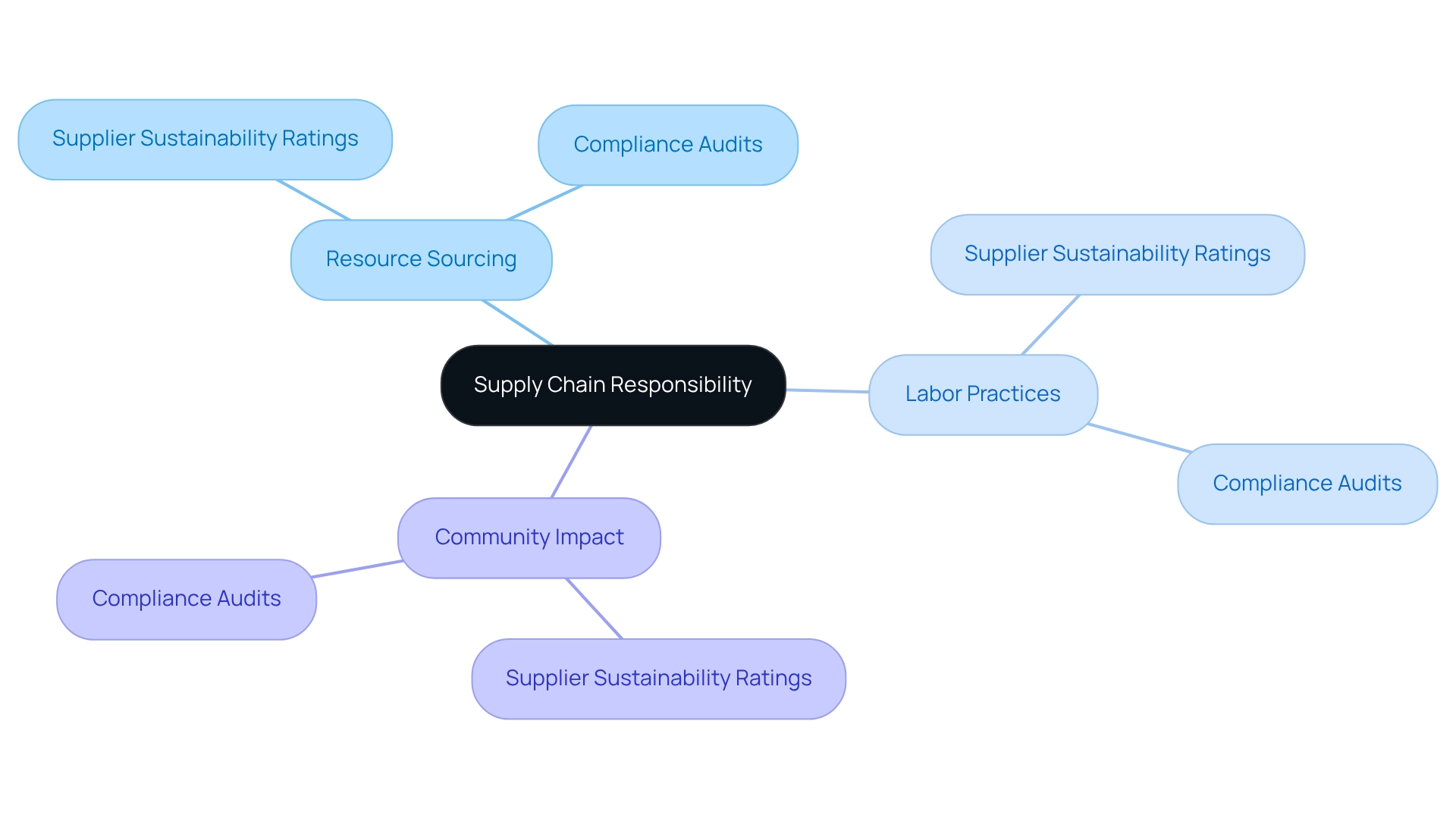
Community Engagement and Impact: Metrics for Stakeholder Relations in Land Acquisition
Community involvement and impact measurements are critical for evaluating stakeholder relationships in land procurement projects. Organizations must monitor indicators such as:
- Community feedback
- Participation rates in public consultations
- The effectiveness of communication strategies
By actively involving local communities and addressing their concerns, companies can establish trust and support for their projects. This approach ultimately leads to smoother procurement processes and an enhanced social license to operate.
Successful strategies for stakeholder relations involve creating lasting connections and partnerships with community members, ensuring their voices are heard and valued. Furthermore, the establishment of an inter-agency group for monitoring public authorities' decision-making transparency reflects a growing commitment to inclusivity in these processes. By emphasizing community involvement indicators, companies can foster beneficial business results while enhancing the overall well-being of the communities they support.
Employee Welfare and Happiness: Metrics for Enhancing Team Performance in Land Acquisition
Employee welfare and happiness metrics are essential for enhancing team performance within property development projects. Companies should actively monitor employee satisfaction through:
- Surveys
- Retention rates
- Engagement scores
Utilizing tools like retention calculators to effectively compare turnover rates. By fostering a positive work environment and addressing employee needs, organizations can boost morale and productivity. Investing in employee well-being not only benefits the workforce but also contributes to the overall success of property procurement initiatives.
Effective wellness programs significantly improve interpersonal dynamics, fostering deeper relationships among employees. Those engaged in recognition activities are seven times more likely to report meaningful connections at work, thereby enhancing overall morale and teamwork. This outcome emphasizes the critical role of recognition in building a cohesive team.
A strategic, long-term approach to employee engagement is vital, particularly in the context of the evolving job market. As industry experts note, companies must adapt their strategies to sustain high levels of employee satisfaction. This flexibility is especially crucial in the property procurement sector, where project success is closely tied to team unity and effectiveness. By addressing employee needs and promoting a positive work atmosphere, organizations can not only enhance productivity but also ensure the success of their property development initiatives.
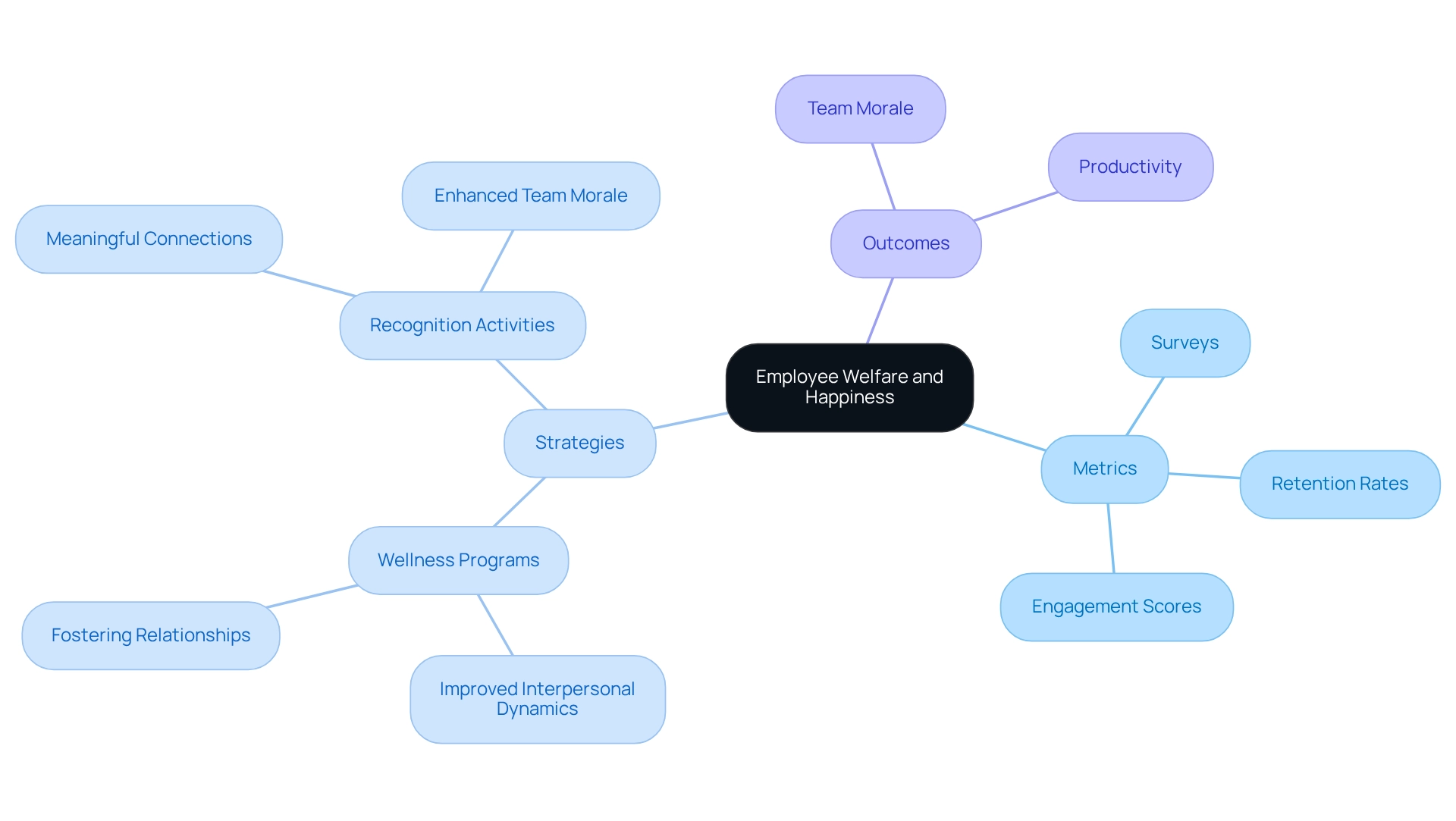
Governance Impact: Metrics for Ensuring Transparency in Land Acquisition
Governance impact indicators are critical for ensuring transparency in property acquisition processes. Organizations must establish clear governance structures that integrate metrics for compliance, stakeholder engagement, and ethical standards. Regular audits and transparent reporting mechanisms are vital for maintaining accountability and fostering trust with stakeholders. In 2025, statistics reveal that 27% of security and IT experts identify reducing internal audit fatigue as a significant compliance challenge, underscoring the urgent need for effective governance strategies in the services sector. By prioritizing governance, companies can bolster their reputation and mitigate risks associated with property acquisition.
Moreover, effective transparency practices, as illustrated by the case study on resource governance in Kenya, underscore the importance of sound governance in property administration. This study highlights the necessity for effective land tenure and equitable land allocation, offering a framework for evaluating transparency and accountability. Additionally, companies that fail to manage water risk effectively could face annual costs exceeding $1 trillion by 2050, further emphasizing the critical role of governance in environmental performance indicators.
To enhance governance practices, organizations should consider implementing employee training initiatives. Anna Fitzgerald, Senior Content Marketing Manager, emphasizes that such training is among the most effective cost reducers for data breaches. Ultimately, establishing governance indicators for transparency in property procurement is essential for organizations striving to navigate the complexities of compliance and ethical practices in the evolving landscape of real estate services.
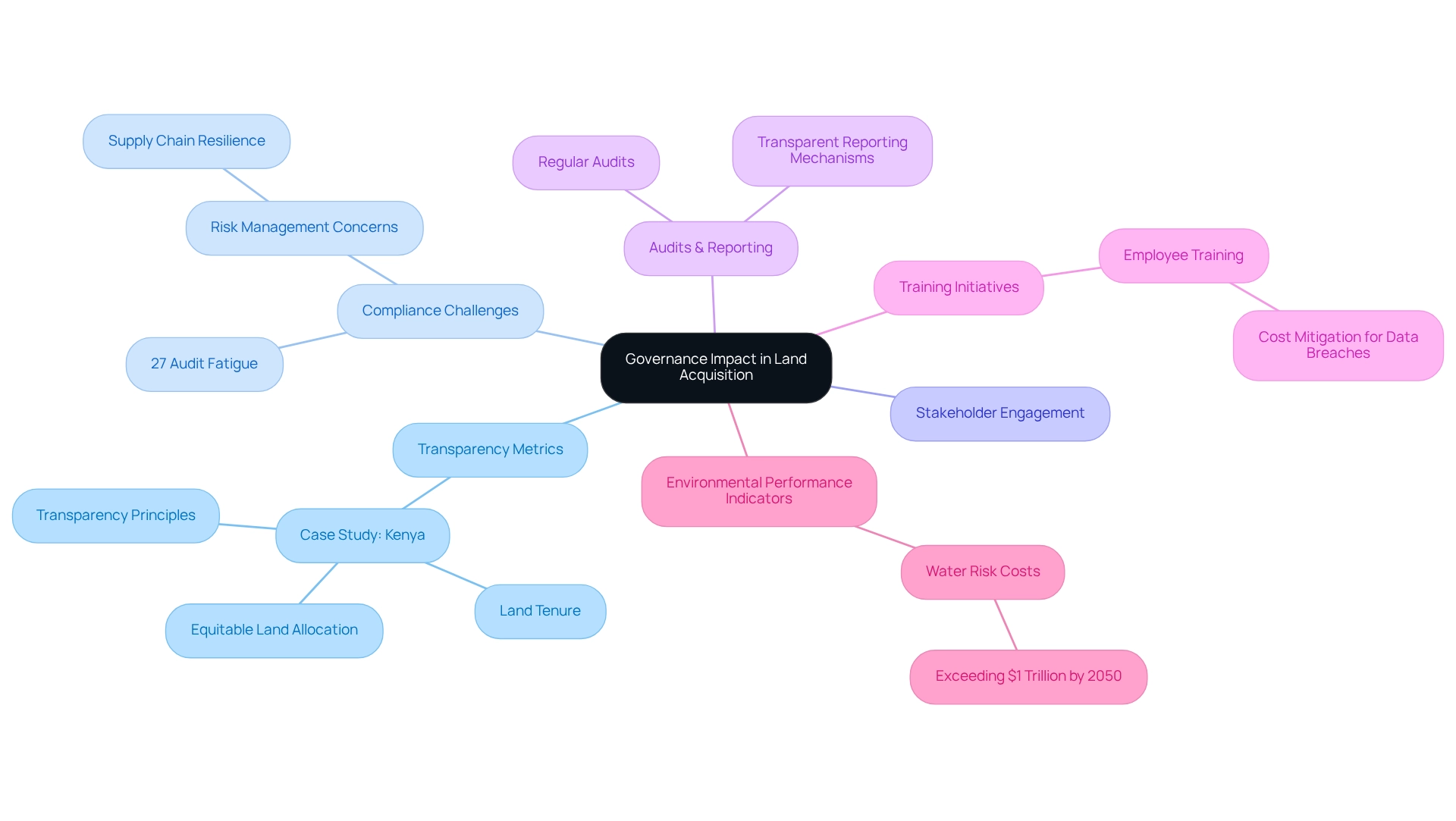
Longevity of Business Operations: Metrics for Assessing Long-Term Viability in Land Acquisition
Assessing the durability of business operations is crucial for evaluating the long-term feasibility of property investment strategies. Companies must scrutinize their operational sustainability through various metrics, including ecological performance metrics alongside financial performance, market adaptability, and resilience to regulatory changes. In 2025, a significant 61% of industry respondents will prioritize Building Performance Standards during due diligence, underscoring the growing emphasis on sustainability in real estate transactions. This trend aligns with findings that successful sustainability initiatives depend on how capital investments are prioritized, highlighting the imperative for organizations to focus on long-term sustainability goals.
By aligning property procurement efforts with these objectives, organizations can enhance their business outcomes while contributing positively to environmental stewardship. Furthermore, as the market adapts to evolving demands, companies that integrate sustainable practices into their operational frameworks are better positioned to thrive amidst regulatory shifts and market fluctuations. Tim Coy, a senior research leader at the Deloitte Center for Financial Services, emphasizes that concentrating on ecological performance metrics not only promotes business longevity but also ensures that property acquisition initiatives are both economically viable and environmentally responsible. This strategic focus on ecological performance metrics is essential for Directors of Land Acquisition as they navigate the complexities of modern land services.
Are your current practices aligned with the sustainability metrics that will define future success? Embrace this approach to ensure your organization remains competitive and responsible in the ever-evolving landscape of land acquisition.
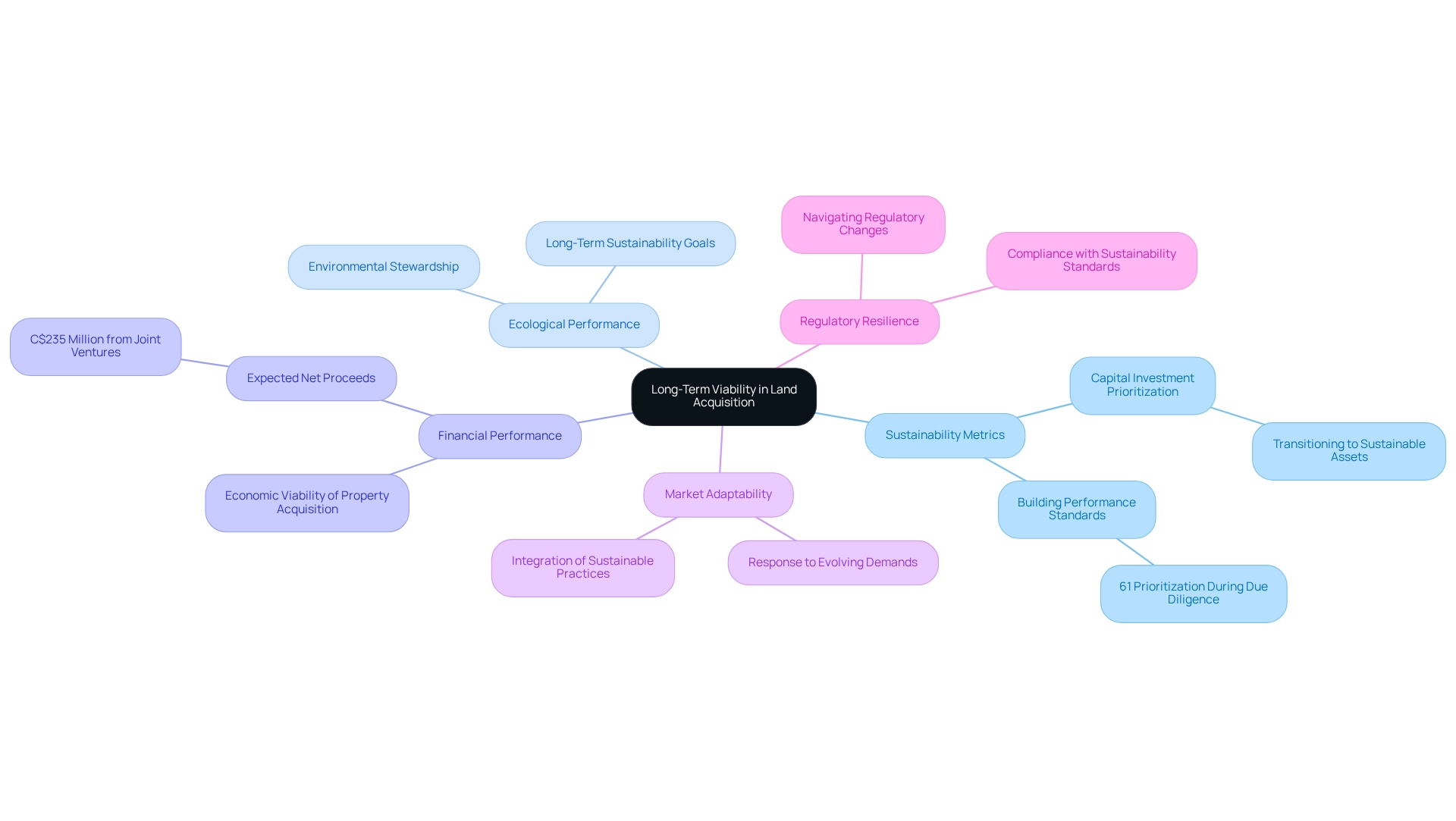
Conclusion
The integration of sustainability metrics into land acquisition processes stands as a strategic imperative, transcending mere regulatory compliance for organizations in the energy and infrastructure sectors. By concentrating on key performance indicators such as carbon emissions, water usage, waste management, and community engagement, companies can significantly enhance their ecological performance and reputation. This commitment to sustainability not only aligns with regulatory standards but also fosters a positive relationship with stakeholders and the communities they serve.
As the industry grapples with challenges like rising costs and profit declines, leveraging innovative technologies and comprehensive strategies becomes essential. Organizations such as Harbinger Land exemplify how the application of cutting-edge tools can streamline processes and improve operational efficiency, positioning themselves as leaders in sustainable land services. Moreover, the focus on metrics related to employee welfare, governance, and supply chain responsibility highlights the holistic approach necessary for achieving long-term viability in land acquisition.
Ultimately, by prioritizing sustainability in their operational frameworks, organizations can adeptly navigate the complexities of modern land services while contributing positively to environmental stewardship. This strategic focus not only ensures compliance but also cultivates resilience and adaptability, paving the way for a more sustainable future in land acquisition practices. As the landscape continues to evolve, the commitment to these principles will be crucial for success in the years ahead.
Frequently Asked Questions
What services does Harbinger Land provide for energy and infrastructure projects?
Harbinger Land offers comprehensive services that include site and right-of-way procurement, title research, GIS mapping, and data processing.
What challenges is the property acquisition sector facing in 2025?
In 2025, the property acquisition sector is facing significant challenges such as profit declines due to slow growth and rising expenses.
How does Harbinger Land differentiate itself in the industry?
Harbinger Land distinguishes itself by leveraging cutting-edge technology, including AI-powered title research software, to enhance operational efficiency and client satisfaction.
Who are the typical clients of Harbinger Land?
Harbinger Land's clients include natural gas companies, solar developers, and municipalities.
What is the importance of adaptability in Harbinger Land's services?
Adaptability is crucial as it allows Harbinger Land to swiftly deploy large teams to meet diverse project demands, ensuring timely and tailored services for clients.
What innovative solutions are mentioned as impacting land planning and development?
Innovative solutions like Autodesk Forma are revolutionizing land planning and development.
What are ESG criteria and why are they important?
ESG criteria represent vital standards for evaluating a company's commitment to sustainable practices, including carbon emissions, water consumption, waste management, and community involvement. They are important for enhancing reputation and ensuring compliance with regulatory standards.
How can companies integrate ESG criteria into property procurement processes?
By integrating ESG criteria into property procurement processes, companies can improve their ecological performance metrics and align operations with sustainability objectives.
Why is managing carbon emissions significant for property acquisition projects?
Managing carbon emissions is significant because organizations need to assess their carbon footprint, which includes emissions from use changes, transportation, and construction activities, to comply with environmental regulations and enhance sustainability profiles.
What tools can help organizations quantify and manage carbon emissions?
Tools such as carbon calculators and life cycle assessments are crucial for quantifying emissions and identifying reduction opportunities.
What recent trends are impacting the scrutiny of carbon emissions in property development?
There is increasing scrutiny of carbon emissions from property development projects, with heightened attention on their impacts during environmental evaluations.
List of Sources
- Harbinger Land: Comprehensive Solutions for Land Services in Energy and Infrastructure
- Land Development in the US - Market Research Report (2015-2030) (https://ibisworld.com/united-states/industry/land-development/167)
- Global Land Planning And Development Market Report 2025 - Trends And Drivers To 2034 (https://thebusinessresearchcompany.com/report/land-planning-and-development-global-market-report)
- ESG Criteria: Key Metrics for Evaluating Ecological Performance
- 80+ Sustainability Statistics for 2025: Ultimate List (https://arbor.eco/blog/sustainability-statistics)
- 50 ESG & Sustainability Facts & Statistics [2025] (https://digitaldefynd.com/IQ/surprising-esg-statistics)
- travelperk.com (https://travelperk.com/blog/business-sustainability-statistics)
- 50 Sustainability Statistics: Must Know In 2025 | KEY ESG (https://keyesg.com/article/50-esg-statistics-you-need-to-know-in-2024)
- Carbon Emissions: A Critical Metric for Environmental Impact Assessment
- Global Carbon Budget 2024 (https://essd.copernicus.org/articles/17/965/2025)
- Carbon Emission Statistics and Facts (2025) (https://coolest-gadgets.com/carbon-emission-statistics)
- Water Usage and Conservation: Essential Metrics for Sustainable Land Management
- Water Use in the United States (https://usgs.gov/mission-areas/water-resources/science/water-use-united-states)
- How Much Water is Used for Farming & Agriculture? (https://coolfarm.org/how-much-water-is-used-for-farming)
- 2023 Irrigation and Water Management data now available (https://nass.usda.gov/Newsroom/2024/10-31-2024.php)
- Waste Management and Reduction: Metrics for Minimizing Ecological Footprints
- Waste and recycling statistics 2025 (https://greyparrot.ai/waste-and-recycling-statistics-2025)
- Waste Management Market Report | Global Forecast From 2025 To 2033 (https://dataintelo.com/report/waste-management-market)
- 74 Recycling Facts & Statistics for 2025 | RTS (https://rts.com/blog/recycling-facts-statistics)
- Supply Chain Responsibility: Metrics for Sustainable Land Acquisition Practices
- Supply Chain Statistics — 70 Key Figures of 2025 (https://procurementtactics.com/supply-chain-statistics)
- Sustainable Procurement Statistics — 50 Key Figures of 2025 (https://procurementtactics.com/sustainable-procurement-statistics)
- Community Engagement and Impact: Metrics for Stakeholder Relations in Land Acquisition
- None (https://opengovpartnership.org/members/republic-of-moldova/commitments/MD0076)
- Top 11 Community Engagement Metrics for 2025 - Bevy (https://bevy.com/b/blog/top-11-community-engagement-metrics-for-2025)
- TOP 25 STAKEHOLDER QUOTES (of 56) | A-Z Quotes (https://azquotes.com/quotes/topics/stakeholder.html)
- Employee Welfare and Happiness: Metrics for Enhancing Team Performance in Land Acquisition
- 2025 Employee Retention & Turnover Statistics You Need to Know (https://inspirus.com/blog/employee-turnover-statistics)
- 59 Employee Engagement Statistics for 2025 | Primeast (https://primeast.com/insights/employee-engagement-statistics)
- elearningindustry.com (https://elearningindustry.com/job-satisfaction-statistics-key-data-and-insights)
- 20 Impactful Workplace Wellness Statistics in 2025 (https://workhuman.com/blog/workplace-wellness-statistics)
- Governance Impact: Metrics for Ensuring Transparency in Land Acquisition
- 50 ESG & Sustainability Facts & Statistics [2025] (https://digitaldefynd.com/IQ/surprising-esg-statistics)
- 110 Compliance Statistics to Know for 2025 (https://secureframe.com/blog/compliance-statistics)
- Assessing transparency and accountability of land governance in Kenya (https://research.utwente.nl/en/publications/assessing-transparency-and-accountability-of-land-governance-in-k)
- Longevity of Business Operations: Metrics for Assessing Long-Term Viability in Land Acquisition
- 2025 commercial real estate outlook (https://www2.deloitte.com/us/en/insights/industry/financial-services/commercial-real-estate-outlook.html)
- CPP Investments Net Assets Total $699.6 Billion at Third Quarter Fiscal 2025 | CPP Investments (https://cppinvestments.com/newsroom/cpp-investments-net-assets-total-699-6-billion-at-third-quarter-fiscal-2025)




